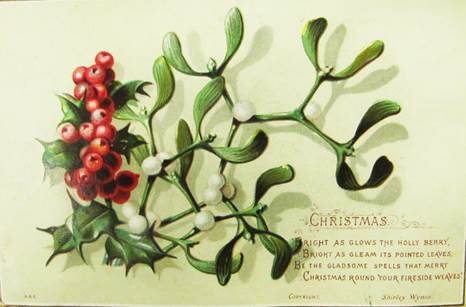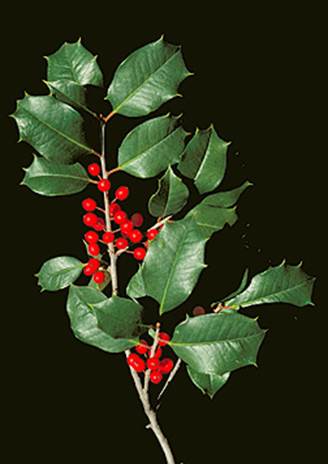Heigh ho! sing heigh ho! unto the green holly:Most friendship is feigning, most loving mere folly:Then, heigh ho, the holly!This life is most jolly.As You Like It. William Shakespeare
American holly is a medium-sized, evergreen, broad-leaved tree of the east coast of the U.S. extending from southern N.J. through the coastal states of the southeastern U.S. to eastern Texas. There is a disjunct population in MA. It commonly grows to 60 feet and up to 100 ft. tall. The trunk is a light gray with warty-looking bumps. The leaves are stiff with several sharp points along the margin with a dull yellow on the underside while the upper leaf is shinny and dark green. Upon arrival in North America the immigrants were immediately struck by the familiarity of this species with its European counterpart, which was used to celebrate the solstice and Christmas. Druids were known to wear holly as a head wreath, which, with its pokey leaves, seems it would be a bit uncomfortable. Holly also fulfills an important role as it is the wood used for Harry Potter’s wand. In pre-Victorian England, a Christmas tree was a holly bush.
The flowers are small and greenish-white and pollinated by a variety of bees, wasps, ants, and moths. Holly is a dioecious (two houses) plant – meaning that some trees are male and others are females; as opposed to monecious (one house) – where a plant has both male and female flowers. The fruits are bright red berries that contrast with the shiny green of the foliage. The berries are poisonous to humans but fed upon by a number of bird species. The wood is relatively white and relatively tough and used for some cabinet work, carving, and painted black – as a substitute for ebony.

This plant has a long history of medicinal use – tea was made from the leaves to reduce the effects of measles, colds, flu, and pneumonia; tea from the bark to aid malaria and epilepsy; and the fruit has strong laxative, emetic, and diuretic qualities. But please note – the fruit can cause violent nausea and vomiting and is considered poisonous – just in case you were considering home remedies.

In Celtic mythology the Holly King was said to rule over the half of the year from summer to the winter solstice, followed by the Oak King to rule until the summer solstice. The tree was thought to have protective properties thus chopping one down could cause a stroke of bad luck. Therefore the tree was often incorporated into hedges and left uncut. This practice also had the benefit of obstructing witches, who were known to run along the top of hedges.
Holly is a common ornamental tree and you can see it planted almost anywhere. Here in Seattle it seems to do quite well and because the berries are eaten by birds the seeds are dispersed all over. When we first moved into our house I removed a line of overgrown conifers along the property edge and just over the property boundary was a huge holly tree. This thing had a trunk of about 25 inches diameter and small holly trees were sprouting up around the base.
Since I was taking out some trees I asked my neighbor if he liked the holly and he said “I hate that thing”.
So it got removed with the rest of the overgrowth. But I still consistently find small seedlings growing up around the house, likely bird deposited from eating fruits on some nearby tree.
